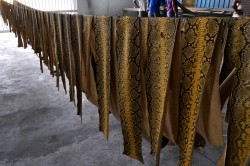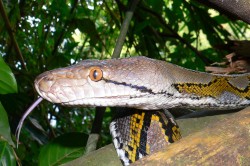Press Release, 30. August 2017
Hope for improving protection of the reticulated python
Scientists look to using genetic data for improving transparency in the skin trade
Trading in skins of the reticulated python is such a lucrative business that illegal exports are rising sharply and existing trade restrictions are being circumvented on a large scale. This is endangering the stability of populations. Therefore, researchers from the Helmholtz Centre for Environmental Research (UFZ) and the Royal Zoological Society Scotland (RZSS) are developing genetic methods for tracking down individual origins and potential trade routes of the skins. Initial results have now been published in the renowned journal PlosOne. They show the genetic variation across reticulated python populations in Southeast Asia, and demonstrate the importance of such data for the long-term conservation of the giant snake species and controlled trade of its skin.

Photo: Mark Auliya, UFZ

Photo: Mark Auliya, UFZ
The reticulated python (Malayopython reticulatus ssp.) lays claim to two records: it is the longest reptile in the world, and it is one of the top reptile species most traded for their skin. Reticulated python skins have been traded commercially for around 80 years. They are an extremely lucrative natural resource for the international fashion industry. Indonesia, Malaysia and Vietnam alone exported almost four million reticulated python skins from 2002 to 2012; at least 75 per cent of these came from "legal" wild harvests. Intense international commerce is, however, calling into question the legality and sustainability of this trade, which is in fact regulated by the Convention on International Trade of Endangered Species of Fauna and Flora (CITES). This is because the reticulated python is one of around 34,000 species in Appendix II of CITES that may only be traded legally with special documents. In reality, however, it is next to impossible to keep track of the trade dynamics of the reticulated python, says Dr. Mark Auliya, an expert for applied species conservation working on international wild animal trade at the UFZ, who also advises the International Union for Conservation of Nature (IUCN), CITES, scientific organisations and customs authorities. In his opinion, management approaches barely exist at the regional and national levels. A number of businesses in the fashion industry therefore see it as their responsibility to support research projects such as that of the UFZ biologist and his Scottish colleague Dr. Gillian Murray-Dickson (RZSS), who aim to develop tests that verify the origin of the skins within the chain of commerce and hence reduce illegal trade.
The researchers investigated the extent to which evolutionary relationships between the populations might be used as reference for the management of catch quotas. For this purpose, they analysed mitochondrial DNA of reticulated pythons from a wide variety of regions within their distribution area. In this process, a clear separation emerged between populations west and east of the so-called "Wallace Line". This imaginary biogeographical line runs across the Malaysian archipelago and separates areas with exclusively Asian fauna from areas that contain not only Asian fauna but also fauna elements of Australian origin. The results show that the reticulated python populations of the Philippines can be clearly distinguished from other populations in the Sunda region, and it is likely that the reticulated python was introduced by humans to the Moluccan island of Ambon.
These findings should, firstly, contribute to the long-term conservation of the genetic diversity of the python. "If the animals of a particular region have their own genetic variation, the population must be managed separately," Mark Auliya explains. Adjusted catch and export quotas can be determined for this purpose, or a trade ban can be imposed if necessary.
Secondly, the genetic investigations can help to verify details relating to the initial export country (assuming that this is the county of origin) or country of origin provided in the CITES documentation - to determine whether the imported skins are indeed from the Philippines or elsewhere, for example. That would facilitate the enforcement of international regulations and significantly restrict illegal schemes.
The research project received financial support from the Moët Hennessy Louis Vuitton (LVMH) conglomerate. It is the leading supplier worldwide of luxury goods, including reptile leather products.
Publication:
Gillian Murray-Dickson, Muhammad Ghazali, Rob Ogden, Rafe Brown, Mark Auliya: Phylogeography of the reticulated python (Malayopython reticulatus ssp.): Conservation implications for the world’s most traded snake species, https://doi.org/10.1371/journal.pone.0182049
Related links:
ZDF / Planet-e: "Snakeskins for Luxury Goods: The Python Code": https://www.zdf.de/dokumentation/planet-e/planet-e-pythoncode-englische-fassung-100.html
UFZ newsletter March 2016 / pages 6 to 8: http://www.ufz.de/newsletter/ufz/Maerz2016/index.html#/6 (available in German only)
Convention on International Trade in Endangered Species of Wild Fauna and Flora (CITES): https://www.cites.org/
International Union for Conservation of Nature and Natural Resources (IUCN): http://www.iucnredlist.org/
Further information
Dr. Mark Auliya
UFZ-Department Naturschutzforschung
mark.auliya@ufz.de
Dr. Gill Murray-Dickson
The Royal Zoological Society of Scotland (RZSS) WildGenes Laboratory
gmdickson@rzss.org.uk
UFZ press office
Susanne Hufe
Phone: +49 341 6025-1630
presse@ufz.de
In the Helmholtz Centre for Environmental Research (UFZ), scientists conduct research into the causes and consequences of far-reaching environmental changes. Their areas of study cover water resources, ecosystems of the future, environmental technologies and biotechnologies, the effects of chemicals in the environment, modelling and social-scientific issues. The UFZ employs more than 1,100 staff at its sites in Leipzig, Halle and Magdeburg. It is funded by the Federal Government, Saxony and Saxony-Anhalt.
www.ufz.deThe Helmholtz Association contributes to solving major challenges facing society, science and the economy with top scientific achievements in six research fields: Energy; Earth and Environment; Health; Key Technologies; Matter; and Aeronautics, Space and Transport. With some 39,000 employees in 19 research centres, the Helmholtz Association is Germany’s largest scientific organisation.
www.helmholtz.de